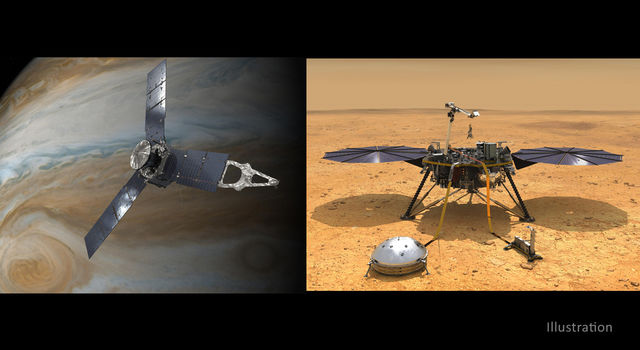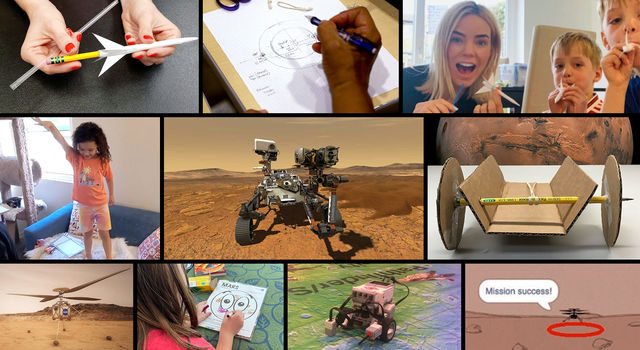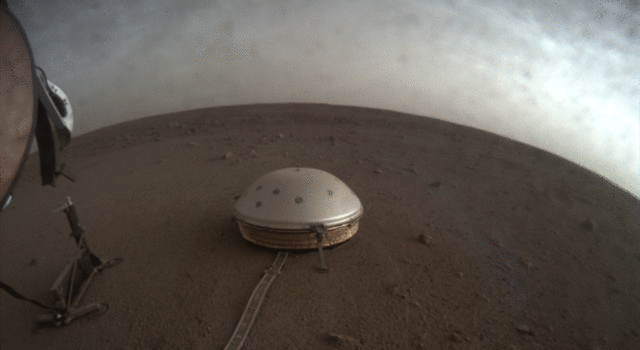Blogs | Dawn Journal | September 27, 2014
It’s No Seven-Year Itch for Dawn: The Dwarf Planet Awaits
Dear Dawnniversaries,
On the seventh anniversary of embarking upon its extraordinary extraterrestrial expedition, the Dawn spacecraft is far from the planet where its journey began. While Earth has completed its repetitive loops around the sun seven times, its ambassador to the cosmos has had a much more varied itinerary. On most of its anniversaries, including this one, it reshapes its orbit around the sun, aiming for some of the last uncharted worlds in the inner solar system. (It also zipped past the oft-visited Mars, robbing the red planet of some of its orbital energy to help fling the spacecraft on to the more distant main asteroid belt.) It spent its fourth anniversary exploring the giant protoplanet Vesta, the second most massive object in the asteroid belt, revealing a fascinating, complex, alien place more akin to Earth and the other terrestrial planets than to typical asteroids. This anniversary is the last it will spend sailing on the celestial seas. By its eighth, it will be at its new, permanent home, dwarf planet Ceres.
The mysterious world of rock and ice is the first dwarf planet discovered (129 years before Pluto) and the largest body between the sun and Pluto that a spacecraft has not yet visited. Dawn will take up residence there so it can conduct a detailed investigation, recording pictures and other data not only for scientists but for everyone who has ever gazed up at the night sky in wonder, everyone who is curious about the nature of the universe, everyone who feels the burning passion for adventure and the insatiable hunger for knowledge and everyone who longs to know the cosmos.
Dawn is the only spacecraft ever to orbit a resident of the asteroid belt. It is also the only ship ever targeted to orbit two deep-space destinations. This unique mission would be quite impossible without its advanced ion propulsion system, giving it capabilities well beyond what conventional chemical propulsion provides. That is one of the keys to how such a voyage can be undertaken.
For those who would like to track the probe’s progress in the same terms used on previous (and, we boldly predict, subsequent) anniversaries, we present here the seventh annual summary, reusing text from last year with updates where appropriate. Readers who wish to reflect upon Dawn’s ambitious journey may find it helpful to compare this material with the logs from its first, second, third, fourth, fifth and sixth anniversaries. On this anniversary, as we will see below, the moon will participate in the celebration.
In its seven years of interplanetary travels, the spacecraft has thrust for a total of 1,737 days, or 68 percent of the time (and about 0.000000034 percent of the time since the Big Bang). While for most spacecraft, firing a thruster to change course is a special event, it is Dawn’s wont. All this thrusting has cost the craft only 808 pounds (366 kilograms) of its supply of xenon propellant, which was 937 pounds (425 kilograms) on Sep. 27, 2007.
The thrusting so far in the mission has achieved the equivalent of accelerating the probe by 22,800 mph (10.2 kilometers per second). As previous logs have described (see here for one of the more extensive discussions), because of the principles of motion for orbital flight, whether around the sun or any other gravitating body, Dawn is not actually traveling this much faster than when it launched. But the effective change in speed remains a useful measure of the effect of any spacecraft’s propulsive work. Having accomplished about seven-eighths of the thrust time planned for its entire mission, Dawn has already far exceeded the velocity change achieved by any other spacecraft under its own power. (For a comparison with probes that enter orbit around Mars, refer to this earlier log.)
Since launch, our readers who have remained on or near Earth have completed seven revolutions around the sun, covering 44.0 AU (4.1 billion miles, or 6.6 billion kilometers). Orbiting farther from the sun, and thus moving at a more leisurely pace, Dawn has traveled 31.4 AU (2.9 billion miles, or 4.7 billion kilometers). As it climbed away from the sun to match its orbit to that of Vesta, it continued to slow down to Vesta’s speed. It has been slowing down still more to rendezvous with Ceres. Since Dawn’s launch, Vesta has traveled only 28.5 AU (2.6 billion miles, or 4.3 billion kilometers), and the even more sedate Ceres has gone 26.8 AU (2.5 billion miles, or 4.0 billion kilometers). (To develop a feeling for the relative speeds, you might reread this paragraph by paying attention to only one set of units, whether you choose AU, miles, or kilometers. Ignore the other two scales so you can focus on the differences in distance among Earth, Dawn, Vesta and Ceres over the seven years. You will see that as the strength of the sun’s gravitational grip weakens at greater distance, the corresponding orbital speed decreases.)
Another way to investigate the progress of the mission is to chart how Dawn’s orbit around the sun has changed. This discussion will culminate with a few more numbers than we usually include, and readers who prefer not to indulge may skip this material, leaving that much more for the grateful Numerivores. (If you prefer not to skip it, click here.) In order to make the table below comprehensible (and to fulfill our commitment of environmental responsibility), we recycle some more text here on the nature of orbits.
Orbits are ellipses (like flattened circles, or ovals in which the ends are of equal size). So as members of the solar system family follow their paths around the sun, they sometimes move closer and sometimes move farther from it.
In addition to orbits being characterized by shape, or equivalently by the amount of flattening (that is, the deviation from being a perfect circle), and by size, they may be described in part by how they are oriented in space. Using the bias of terrestrial astronomers, the plane of Earth’s orbit around the sun (known as the ecliptic) is a good reference. Other planets and interplanetary spacecraft may travel in orbits that are tipped at some angle to that. The angle between the ecliptic and the plane of another body’s orbit around the sun is the inclination of that orbit. Vesta and Ceres do not orbit the sun in the same plane that Earth does, and Dawn must match its orbit to that of its targets. (The major planets orbit closer to the ecliptic, and part of the arduousness of the journey is changing the inclination of its orbit, an energetically expensive task.)
Now we can see how Dawn has been doing by considering the size and shape (together expressed by the minimum and maximum distances from the sun) and inclination of its orbit on each of its anniversaries. (Experts readily recognize that there is more to describing an orbit than these parameters. Our policy remains that we link to the experts’ websites when their readership extends to one more elliptical galaxy than ours does.)
The table below shows what the orbit would have been if the spacecraft had terminated ion thrusting on its anniversaries; the orbits of its destinations, Vesta and Ceres, are included for comparison. Of course, when Dawn was on the launch pad on Sep. 27, 2007, its orbit around the sun was exactly Earth’s orbit. After launch, it was in its own solar orbit.
| Minimum distance from the Sun (AU) | Maximum distance from the Sun (AU) | Inclination | |
|---|---|---|---|
| Earth’s orbit | 0.98 | 1.02 | 0.0° |
| Dawn’s orbit on Sep. 27, 2007 (before launch) | 0.98 | 1.02 | 0.0° |
| Dawn’s orbit on Sep. 27, 2007 (after launch) | 1.00 | 1.62 | 0.6° |
| Dawn’s orbit on Sep. 27, 2008 | 1.21 | 1.68 | 1.4° |
| Dawn’s orbit on Sep. 27, 2009 | 1.42 | 1.87 | 6.2° |
| Dawn’s orbit on Sep. 27, 2010 | 1.89 | 2.13 | 6.8° |
| Dawn’s orbit on Sep. 27, 2011 | 2.15 | 2.57 | 7.1° |
| Vesta’s orbit | 2.15 | 2.57 | 7.1° |
| Dawn’s orbit on Sep. 27, 2012 | 2.17 | 2.57 | 7.3° |
| Dawn’s orbit on Sep. 27, 2013 | 2.44 | 2.98 | 8.7° |
| Dawn’s orbit on Sep. 27, 2014 | 2.46 | 3.02 | 9.8° |
| Ceres’ orbit | 2.56 | 2.98 | 10.6° |
For readers who are not overwhelmed by the number of numbers, investing the effort to study the table may help to demonstrate how Dawn has patiently transformed its orbit during the course of its mission. Note that three years ago, the spacecraft’s path around the sun was exactly the same as Vesta’s. Achieving that perfect match was, of course, the objective of the long flight that started in the same solar orbit as Earth, and that is how Dawn managed to slip into orbit around Vesta. While simply flying by it would have been far easier, matching orbits with Vesta required the exceptional capability of the ion propulsion system. Without that technology, NASA’s Discovery Program would not have been able to afford a mission to explore it in such detail. But now, Dawn has gone even beyond that. Having discovered so many of Vesta’s secrets, the stalwart adventurer left the protoplanet behind. No other spacecraft has ever escaped from orbit around one distant solar system object to travel to and orbit still another extraterrestrial destination. A true interplanetary spaceship, Dawn is enlarging, reshaping and tilting its orbit again so that in 2015, it will be identical to Ceres’.
It may surprise you that if Dawn stopped thrusting today, it would sail out farther from the sun than where it is headed, as shown in the table. We can understand that, however, by thinking carefully about how the craft reaches its target. It has been propelling itself up the solar system hill so it can fly to the vicinity of Ceres, and its own momentum now is sufficient to carry it even beyond. This is little different from driving to a destination with the recognition that near the end of your trip, you need to slow down or you will overshoot. While trajectories that use ion propulsion are much more complicated, that fundamental principle applies. Indeed, Dawn’s speed toward Ceres has been declining since December 2013. In addition to the recent and future ion thrusting that guides the ship smoothly into its new port, the gravity of Ceres itself will help tug Dawn in. We will see more about that next month when we present the revised approach plan.
On Sep. 11, as the spacecraft was engaged in routine ion thrusting, a high-energy particle of space radiation struck an electrical component onboard. That triggered a chain of events that halted thrusting and required the team of flight controllers on distant Earth to leap into action to resume normal operations. Their swift and expert response was successful, and by Sep. 15 the robot was back on duty. In the next log, we will describe what happened on the spacecraft and in mission control. We will also see how navigators take advantage of the tremendous flexibility provided by ion propulsion to devise a new path into Ceres orbit following this interruption in thrust. (As we also will see, the rest of the intricate plans for exploring the dwarf planet will be unchanged. The logs from December 2013 through last month have previews of those plans.)
As Dawn begins the eighth year of its trek through the solar system, Earthlings have a convenient opportunity today to locate the distant spacecraft thanks to the moon. That celestial orb serves as a guidepost to Dawn, which will be well over one thousand times farther away. When the moon rises in the United States later this morning, it will be leading Dawn by less than nine lunar diameters. The sun, moon, planets and stars all appear to move west as Earth rotates on its axis, but the moon itself travels eastward in its orbit quickly enough that it falls behind noticeably over the course of a day. Throughout most of the day today, our natural satellite’s progression will slowly shrink the distance to Dawn. For observes in the eastern part of the country, by the time the moon sets, it will be about one lunar diameter from the spacecraft. For those on the west coast, the moon will be less than its own width from Dawn around sunset. By the time they see the moon setting, Dawn will have passed it and will lead it down to the horizon, the pair still within two lunar diameters of each other. The details are not so important, however. For observers anywhere today, the moon allows us to get a sense of where in the vast sky our faithful explorer is.
Of course Dawn is much, much, much too far away to be seen with our humble eyes. The spacecraft is more than 1.2 million times farther from Earth than the International Space Station is. It is more remote than Mars ever is. The most powerful optical telescopes on high mountains or in orbit could not detect anything nearly as faint as Dawn in the depths of space. Yet readers have ready access to vision far more acute. We can turn our mind’s eye to that part of the sky near the moon. Out there, in that direction, is a probe from Earth, an emissary to the cosmos, silently streaking through the distant void, conducting an ambitious and exciting mission of discovery on behalf of curious and ingenious humans who yearn for new knowledge and new insight and who have an insatiable passion for grand adventures.
Dawn is 2.1 million miles (3.5 million kilometers) from Ceres. It is also 3.37 AU (313 million miles, or 504 million kilometers) from Earth, or 1,290 times as far as the moon and 3.36 times as far as the sun today. Radio signals, traveling at the universal limit of the speed of light, take 56 minutes to make the round trip.
Dr. Marc D. Rayman
4:34 a.m. PDT September 27, 2014
TAGS:DAWN, CERES, VESTA, MISSION, SPACECRAFT, ANNIVERSARY, SOLAR SYSTEM, DWARF PLANETS









